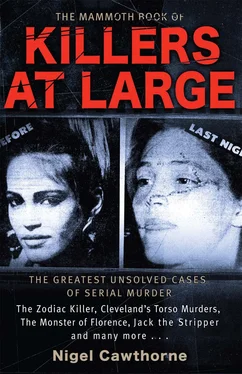“The suspect gets the impression we’re interviewing everyone they know. They begin to think we know about every mistake they make,” he said. “It’s like they’re almost asleep at night and there it is again—ping, ping, ping on the roof.”
Four days after the first interview, Stella Nickell called Cusack and agreed to take the lie-detector test. Once she was hooked up to the polygraph machine, Cusack asked if she put cyanide in Excedrin capsules. She calmly denied it, but the jump in the needles measuring her pulse rate and her breathing told a different story.
Unfortunately, polygraph tests are rarely admissible in court, so Cusack switched the machine off.
“Based on your physiological responses,” he said, “I am positive you caused Bruce’s death.”
“I want to see my attorney,” said Stella Nickell. It was plain that Cusack was not going to get a confession.
Cusack had already questioned Cindy Hamilton, Stella Nickell’s 27-year-old daughter from a previous marriage. She had defended her mother but, hearing about the result of the polygraph test, she was beginning to have second thoughts. When Cusack questioned her for a second time, she said that her mother had talked about killing her stepfather for years. She was bored, but she did not want a divorce because she would lose half of their meagre property. She had even talked of hiring a hit man to shoot Bruce or run his car off the road. Once, she tried to poison him with foxglove seeds, but they only made him drowsy. Then, a few months before his death, Cindy said, Stella began talking about cyanide. When Bruce died, Cindy talked over the matter with her mother.
“I know what you’re thinking,” said Stella, “and the answer is no.”
Cindy had allayed her suspicions until the polygraph results revived them.
“I knew my mother was capable of doing this,” she said. “I just didn’t want to believe it.”
Slowly, a nine-hour interview with Cusack brought home to Cindy the enormity of what her mother had done. She had killed an unsuspecting victim to make the murder of her husband seem like the random act of a deranged poisoner. What if Sue Snow’s daughter Hayley had taken the capsules that morning? What if the other two bottles had found their way into people’s homes? How many people would Stella Nickell have killed for an extra $105,000?
Cindy agreed to testify against her mother as long as she did not have to face the death penalty. Cusack assured her that a Federal conviction for product-tampering conviction carried a maximum sentence of life imprisonment.
But there was still no smoking gun. Cindy had not seen her mother put the cyanide in capsules, administer them to her husband or place the contaminated bottles in stores. In court, her testimony could be dismissed as a feud between mother and daughter. Indeed, the maternal bond was strong and she might deny everything in court.
As the grand jury began hearing testimony in February 1987, the FBI team had shrunk to just three men—Cusack, Nichols and a rookie named Marshall Stone. Desperately they tried to put together the last link in the chain of evidence against Stella Nickell. But most of the leads they checked out went nowhere. Then Cusack remembered that Cindy had told him, in the months before her stepfather’s death, her mother had been researching in libraries. Stone headed for Stella Nickell’s local library in Auburn.
“Do you have a library-card holder by the name of Stella Nickell?” he asked the librarian. She searched the files and handed to Stone an overdue notice for a book Stella had borrowed and never returned. Its title: Human Poisoning .
Armed with the number Stella Nickell’s library card, Stone combed the aisles for other books on toxicology. He found a volume on poisonous plants called Deadly Harvest . Stella Nickell’s library number had been stamped twice on the checkout slip—and both dates were before her husband’s death. The book was sent off to Washington, DC, where the FBI crime lab found 84 of Stella’s prints in Deadly Harvest —mostly on the pages covering cyanide.
On 9 December 1987, Stella Nickell was charged with the murder of her husband and Sue Snow. When her trial began four months later, she pleaded not guilty. It took 31 witnesses to piece together a portrait of a woman whose unhappy marriage and financial desperation led to her to see random acts of murder as a solution. The prosecutor called her an “icy human being without social or moral conscience”.
The jury found her guilty on 9 May. Saying her crimes exhibited “exceptional callousness and cruelty”, Judge William Dwyer sentenced her to 99 years, with no consideration of parole for 30 years.
As a result of the case, the FDA tightened its regulations, setting national requirements of anti-tampering protection for over-the-counter medicines. The maker of Excedrin, Tylenol and other non-prescription drugs stopped using two-piece capsules that could easily be pulled apart, refilled and pushed back together. They were replaced with one piece “caplets” in an attempt to prevent tampering by crazed killers. It failed.
On the evening of 2 February 1991, Jennifer Meling collapsed in the apartment she shared with her husband Joseph in Tumwater, Washington, after taking the decongestant Sudafed. Earlier the couple had been separated and Jennifer had filed for divorce, but now they were now reconciled. When she lapsed into unconsciousness, her 31-year-old husband called 911.
Rushed to hospital, emergency room staff had trouble identifying what was wrong with her. Joseph Meling then suggested that they look for signs of cyanide poisoning. Cyanide was found in her blood, but Jennifer recovered. Unfortunately that was not the end of the matter. In attempting to murder his wife to cash in on a $700,000 life assurance policy he had taken out on her, he had tried to cover his tracks with more product tampering.
On 11 February, 40-year-old Kathleen Daneker died of poisoning in Tacoma. The Pierce County coroner found cyanide in her body on 1 March. In her home, the police found Sudafed capsules which they took to Seattle where they confirmed they had been tampered with.
By then 44-year-old Stanley McWhorter of Lacey, Washington, had died shortly after taking a Sudafed capsule on 18 February. Once the Pierce County findings came to light, the Thurston County coroner checked McWhorter’s body and found cyanide.
The following day, nearly all of FDA’s Seattle district’s employees, along with investigators from the agency’s offices in Spokane, Yakima and Portland, Oregon, started removing Sudafed capsules from store shelves. Over the next three weeks, district investigators worked around the clock collecting the drug from all stores along the 47-mile stretch of Interstate 5 from Olympia, Washington, north to South Seattle. Some 248,000 capsules were collected and screened.
One contaminated Sudafed capsule was found at a Pay ’n’ Save Drug Store in Tacoma, about 30 miles from Tumwater. Two consumers returned packages each containing one cyanide-laced capsule that they had purchased at the Drug Emporium Store No. 6 and a K-mart Discount Store, both in Tacoma.
Although Jennifer Meling stood by her husband and testified for the defence at his trial, Joseph Meling was found guilty of two counts of murder, one attempted murder, six counts of product tampering and three counts of mail fraud. On 8 June, he was sentenced to two concurrent life terms plus 75 years in prison, with no possibility for parole.
The judge said that Meling’s “planning and preparation for the crime was extraordinary, detailed and elaborate, and it was only through good fortune that more persons didn’t die”.
In addition, Meling was ordered to pay $3.5 million in restitution to Burroughs-Wellcome, the manufacturer of Sudafed, and $4,794.29 to Blue Cross for his wife’s medical bills. Any money Meling earns through media contracts and book royalties will be used to make the restitution.
Читать дальше











